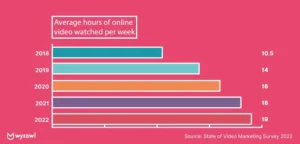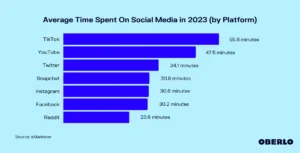When The Buggles sang “Video Killed the Radio Star,” they voiced a sentiment of concern that resonated with the evolving technological landscape and its impact on the music industry. The rise of video as a medium brought forth questions about how it would transform and shape the way music was experienced and consumed.
Today, video has undeniably solidified itself as a pillar of content creation and has become an imperative part of the marketing mix. As video has climbed to a place of importance, the soundtrack and voiceover have also come to play a critical role in determining the success or failure of video content.
Keep reading to learn more about the importance of audio in video marketing.
Video is an important medium for brands
Before we dive into why audio is so important in video, let’s review how significant this visual medium is to brands. Video has become a ubiquitous form of communication and entertainment. It has permeated social media and marketing and has emerged as a powerful tool for marketers to engage with target audiences. Smartphones have provided hand-held, portable screens for everyone to easily access video, and over the last few years consumption has increased by 215%. In 2022, audiences spent an average of 19 hours per week consuming online video.

Additionally, platforms which focus on video garner the most time spent per day. TikTok, which focuses on short-form video, averages 55.8 minutes of view time a day, and YouTube, which offers a wide range of video length and content styles, averages 47.5 minutes.

Moreover, platforms that don’t present video as a key, native element, but offer upload as a capability also see positive performance for posts which include the visual medium. Hubspot notes:
- Tweets with video get 10 times more engagement
- LinkedIn is on video marketers’ radar with 68% planning to use it this year
- Users on Pinterest watch almost a billion videos a day
While visually stunning videos can grab attention, it is the audio that often creates a deeper emotional connection and enhances the overall experience.
The role of the soundtrack
The soundtrack of a video serves as its auditory identity, setting the mood and evoking the desired emotions. The choice of music, whether it’s an original composition or a licensed track, can greatly influence how viewers perceive the content and if the message is remembered and reinforced. A strategic soundtrack can help create the feeling of an authentic and relatable narrative, bolstering the impact of visuals and leaving a lasting impression on the target audience. Conversely, a poorly chosen or executed soundtrack can detract from the video’s message and diminish its effectiveness.
The role of voiceover
Voiceover is another crucial element that can make or break a video. Voiceover is used to tell a story, provide explanation or help the audience emotionally connect with the visual. An accomplished narrator with a charismatic voice can effectively convey information and guide the viewer through the content. The voiceover can also reinforce the tone, emotion and brand voice of the marketing piece. A compelling voiceover can enhance the storytelling, establish credibility and keep the audience engaged. On the other hand, a weak or monotonous voiceover can undermine the video’s impact, leaving the viewer disinterested or disconnected from the intended message.
How audio affects the overall video experience
Obviously visuals that capture the target’s attention are important, but the audio can affect how the video is received overall. It’s important to include audio as part of video’s main strategy and discuss a plan for the audio prior to shooting any video footage.
Here are a few ways in which audio boosts the performance of video:
Communication
The audio in a video helps to convey the message to the viewers. While visuals can provide context and add to the story, audio is often the primary source of information and communication in a video. Both the soundtrack and voiceover will relay the message and lead the target audience toward the wanted feeling or action. This is particularly true for explainer videos, that need to have clear language and effective communication to impart necessary information to the target audience.
Imagine if you’re trying to learn about a product or service, and the person explaining everything in the video is mumbling or the sound is so low they are hard to hear over the background music. You will likely not finish watching the video, and ultimately won’t move forward with that purchase.
Check out Purina’s explainer video that makes great use of voiceover and background music:
Video credit: Mac Wojcik on Vimeo
Emotional impact
Audio can create an impact on the viewer that complements the visuals. Music, sound effects and voiceovers can add depth to the story and elicit a specific emotional response. Background music, music with lyrics or professional voiceover from a performer will give the target audience the emotional input needed to connect on a deeper level with the brand.
Quality
High-quality audio can enhance the overall production value of a video. Poor audio quality can be distracting, take away from the message and make the content less engaging. The importance of audio quality cannot be understated. Clarity, balance and appropriate volume levels will ensure that the audio elements do not overpower or get overshadowed by the visuals. If the audio quality is subpar, viewers may be more likely to abandon the video, regardless of its visual appeal.
Accessibility
Audio is critical for accessibility. Those who have vision loss or are blind will depend only on the sound of the video to receive the message. Equally, closed captioning and subtitles can help viewers with hearing difficulties or those who may not understand the spoken language to follow the story. Be sure to use descriptive words in the captions to help viewers grasp the vibe you’re creating.
Atmosphere
Audio isn’t only music and voice, it can also include other sounds that set the stage for your marketing piece. The running faucet in the background of a kitchen scene, animal or wildlife sounds, the bustle of traffic on a busy road and other atmospheric sounds contribute to the overarching feeling of the video. It’s essential that these don’t sound fake, feel over the top, are not quite matched for the visual or ill-timed, as any dissonance can take the viewer out of the moment.
GoPro uses only atmospheric sounds at the beginning of its video showing a fireman saving a kitten and it is incredibly effective:
Video credit: GoPro
Tips for audio usage in marketing videos
Here are some tips for making sure the audio in your marketing video will connect with your target audience:
- Consider brand voice – You’ll want the audio to reflect your brand tone and voice. If it doesn’t it can cause confusion for your audience. Is your brand happy and peppy? Then your soundtrack and voiceover should be as well. Does your brand tackle a more challenging problem? Then perhaps a more subdued soundtrack is the way to go.
- Speaks to your audience – Some audio pieces, such as hit songs, were so big that entire groups will have an emotional response. Consider audio that will be nostalgic, inspirational or will otherwise resonate with your target audience.
- Jingles work – It is more of an investment to get a customized jingle for your brand, but they work! Even a small sound associated with your logo can help retention of your message. This is sometimes referred to as sonic branding. Popular jingles that have had strong performance and recollection include McDonald’s “I’m Lovin’ It,” Folger’s “The Best Part of Waking Up, is Folger’s in Your Cup” and State Farm’s “Like a Good Neighbor, State Farm is There.” Sonic branding that has made a mark include audio for the Netflix logo, the THX audio trademark seen at the theater and the click of the Nintendo Switch remotes on its animation.
- Go silent – In some cases it’s appropriate to cut all sound from your marketing piece. This works best when it’s used to take a beat and give the audience a moment to think about what just happened visually in your ad or to emphasize the significance of what was just said or seen in the video.
- Use a famous sound, voice or speech – You hear this a lot in political ads, but it can work for your brand as well. Using a snippet of a famous sound, speech or sound bite can associate your brand with another important piece of history or pop culture. Defining soundbites include the Jaws shark theme (daah, duuh), Homer Simpson saying “D’oh,” or pretty much anything in the very recognizable baritone of Morgan Freeman. It is absolutely critical if you’re using these types of assets to go through the proper channels and get a license. Additionally, if the sound bite has a deep meeting, it needs to be used respectfully and in the tone of the original content.
Volkswagen tapped an iconic pop culture theme for one of its Super Bowl commercials several years ago:
Video credit: Volkswagen of Puyallup
Radio and video stars are alive and working together
Video has become an integral part of modern marketing, and it is the audio components that can truly make or break the success of video content. The right choice of soundtrack, complemented by a skilled voiceover and high-quality audio production can elevate the video and create a more immersive experience which resonates with the audience on a deeper level. Audio can help the target audience develop an emotional response to your brand and can lead to the decision to purchase your product or service.
Neglecting or mishandling the audio aspects of your marketing video can undermine its impact, potentially leading to a loss of engagement, interest and ultimately, the video’s effectiveness as a marketing tool. It could even deter a customer from purchase.
While some might say that video killed the radio star, we know that the audio is a critical part of how video is received and retained.
The experts at Beyond Fifteen can help your brand make the most of video, including selecting the right audio for your marketing piece. Connect with us to learn more!
